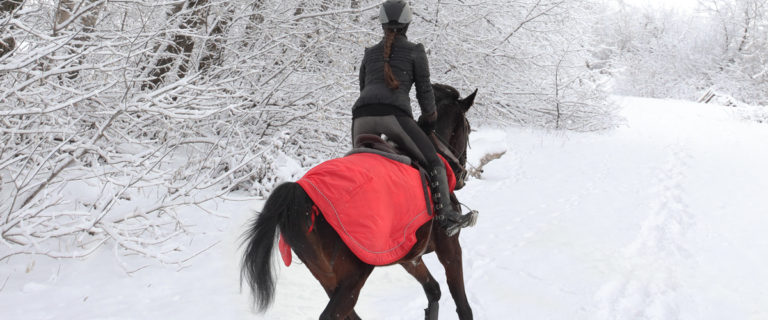You’re winter riding routine should be different from your summer routine. Here are some things to add and be mindful of during your rides this winter!
Before You Get On
- Cold weather does not bode well for leather tack. If your leather tack is harder than usual make sure to oil it before use. The cold weather can cause leather to dry out and crack which can be unsafe for you and your horse and could cause a tack malfunction.
- Dress yourself appropriately. You will not perform your best if you are shivering from the cold while riding. You might want to invest in warm winter gear such as gloves, boots, jackets, and riding pants to keep yourself comfortable so you can focus on your ride. They even make warm headgear to put around your helmet.
- Consider talking to your farrier about winter hoof care before you ride your horse on hard, icy, or snowy ground. Sometimes farriers use special shoes and pads to make the horse more comfortable during the winter.
- If your horse rides in a bit, consider getting a bit warmer to save your horse the uncomfortable sensation of having a cold piece of metal in their mouth.
- Quarter sheets are great for your horse in winter to stay warm while working, especially if he’s clipped.

When you Ride
- Your horse is more stiff in the winter so carve out more time to warm up before doing harder work.
- Plan your workouts accordingly. Take extra precautions if the ground is snowy or hard, you can damage your horse’s joints if they are having to work harder in less than ideal conditions.
- If you are not riding in an arena be extremely cautious when riding. You can’t see through snow, and neither can your horse so if you’re on a trail be overly cautious of where your horse is stepping.
- Add extra time to cool down your horse. It can be dangerous to not cool down your horse properly before putting his blanket back on. Leaving more time for the sweat to evaporate and for his body to regulate itself will greatly benefit your horse.
Post Ride
- Once your horse is done cooling out and you unsaddle them consider putting on a cooler before his blanket. Blankets trap in moisture that could be trying to evaporate. When your horse is completely dry then you can put on their blanket.
There are plenty of ways you can safely enjoy winter riding, as long as you and your horse are as safe and comfortable as possible!

